10 Best Blue Carbon Offsets (Complete 2024 List)
Impactful Ninja is reader-supported. When you buy through links on our site, we may earn an affiliate commission.
Learn more
Learn more
.
Hey fellow impactful ninja ? You may have noticed that Impactful Ninja is all about providing helpful information to make a positive impact on the world and society. And that we love to link back to where we found all the information for each of our posts. Most of these links are informational-based for you to check out their primary sources with one click. But some of these links are so-called "affiliate links" to products that we recommend. First and foremost, because we believe that they add value to you. For example, when we wrote a post about the environmental impact of long showers, we came across an EPA recommendation to use WaterSense showerheads. So we linked to where you can find them. Or, for many of our posts, we also link to our favorite books on that topic so that you can get a much more holistic overview than one single blog post could provide. And when there is an affiliate program for these products, we sign up for it. For example, as Amazon Associates, we earn from qualifying purchases. First, and most importantly, we still only recommend products that we believe add value for you. When you buy something through one of our affiliate links, we may earn a small commission - but at no additional costs to you. And when you buy something through a link that is not an affiliate link, we won’t receive any commission but we’ll still be happy to have helped you. When we find products that we believe add value to you and the seller has an affiliate program, we sign up for it. When you buy something through one of our affiliate links, we may earn a small commission (at no extra costs to you). And at this point in time, all money is reinvested in sharing the most helpful content with you. This includes all operating costs for running this site and the content creation itself. You may have noticed by the way Impactful Ninja is operated that money is not the driving factor behind it. It is a passion project of mine and I love to share helpful information with you to make a positive impact on the world and society. However, it's a project in that I invest a lot of time and also quite some money. Eventually, my dream is to one day turn this passion project into my full-time job and provide even more helpful information. But that's still a long time to go. Stay impactful,Affiliate Disclosure
Why do we add these product links?
What do these affiliate links mean for you?
What do these affiliate links mean for us?
What does this mean for me personally?
![]()
Blue carbon is the carbon stored in coastal marine ecosystems. Partnered with carbon offsets, blue carbon has the potential to play a major role in climate change mitigation because it increases the amount of marine vegetation and protects areas capable of absorbing large amounts of carbon annually. So, we had to ask: what are the best blue carbon offsets?
The best blue carbon offsets are offered by The Ocean Foundation, SeaTrees, and One Tree Planted, which protect seagrasses, watersheds, and mangrove communities. In addition, Reforest’Action plants mangrove forests in Sumatra and South Pole restores Indonesian peat swamp forests.
Keep reading to learn more about the best blue carbon offsets, how these carbon offset projects work, and what their respective offsetting costs are. At the end of the article, we’ll also share with you how effective blue carbon offsets are, what their pros and cons are, and how these offsets can help mitigate climate change.
Here’s What All the Best Blue Carbon Offsets Have in Common
Carbon offsets are reductions in carbon emissions that are used to compensate for carbon emissions occurring elsewhere. They are measured in tons of carbon dioxide (CO2) equivalents and are bought and sold through international brokers, online retailers, and trading platforms on what is known as the global carbon offset market.
“Carbon offset: a way for a company or person to reduce the level of carbon dioxide for which they are responsible by paying money to a company that works to reduce the total amount produced in the world, for example by planting trees”
Oxford Dictionary
Blue carbon refers to carbon stored in coastal and marine ecosystems (e.g., mangroves, tidal and salt marshes, and seagrasses). There are over 120 million acres of blue carbon ecosystems worldwide that provide habitat, support food security, sustain coastal communities, and protect our coastlines.
“Blue Carbon: the term for carbon captured by the world’s ocean and coastal ecosystems.”
National Oceanic and Atmospheric Administration
Blue carbon is one example of biological carbon sequestration, or the storage of carbon in vegetation (forests), soils, and oceans, which are commonly referred to as our carbon sinks. Mangroves and salt marshes can absorb 3-5x more carbon per acre than tropical forests at a rate 10x greater.
However, blue carbon ecosystems are currently being degraded at 4x the rate of tropical forests, making them one of our most threatened ecosystems. Their carbon absorption abilities and the ecosystem services they provide make protecting them crucial in the fight against climate change.
These Are the 10 Best Blue Carbon Offsets in 2024
Below are our favorite blue carbon offsets (you can click on their link to directly jump to their section in this article):
| Blue Carbon Offsets | Quick Facts |
| The Ocean Foundation | About: Carbon offset purchases support the SeaGrass Grow, seagrass planting project. Costs: $20 per 1,000kg of CO2 |
| SeaTrees | About: Carbon offset purchases support coral reef/kelp forest/watershed restoration as well as mangrove tree planting. Costs: $22 per 1,000kg of CO2 |
| One Tree Planted | About: Carbon offset purchases support their mangrove planting blue carbon project, which plants mangrove trees in Costa Rica, the Philippines, India, Haiti, and Guatemala. Costs: $20 per 1,000kg of CO2 |
| Reforest’Action | About: Carbon offset purchases support the mangrove restoration projects in Sumatra. Costs: Approx. $20 per 1,000kg of CO2 |
| South Pole | About: Carbon offset purchases support the Rimba Raya Biodiversity Preserve project on the island of Borneo in Indonesia and the Muskitia blue carbon project in Honduras. The project protects over 200 thousand acres of tropical peat swamp. Costs: $21.55 per 1,000kg of CO2 |
| Sustainable Travel International | About: Carbon offset purchases support the Katingan Mentaya Blue Carbon Project. This project protects and restores 370,000+ acres of peat swamp forest in Borneo. Costs: $16 per 1,000kg of CO2 |
| Restore the Earth Foundation | About: Carbon offset purchases support wetland reforestation in the Lower Mississippi River Basin, also known as the North American Amazon. Costs: Costs are determined after initial contact |
| Ecologi | About: Carbon offset purchases support two coastal mangrove planting projects in Madagascar and one in Mozambique. Costs: $6.04 per 1,000kg of CO2 |
| The Carbon Offset Company | About: Carbon offset purchases support their mangrove reforestation blue carbon project located in Casa Partida, Mozambique. Costs: Costs are determined after initial contact |
| myclimate | About: Carbon offset purchases support the Blue Forests for Coral Reef Protection project, which protects over 2,400 acres of mangrove forests in Madagascar. Costs: $23-$30 per 1,000kg of CO2 |
The Ocean Foundation: A Community Foundation for the Ocean
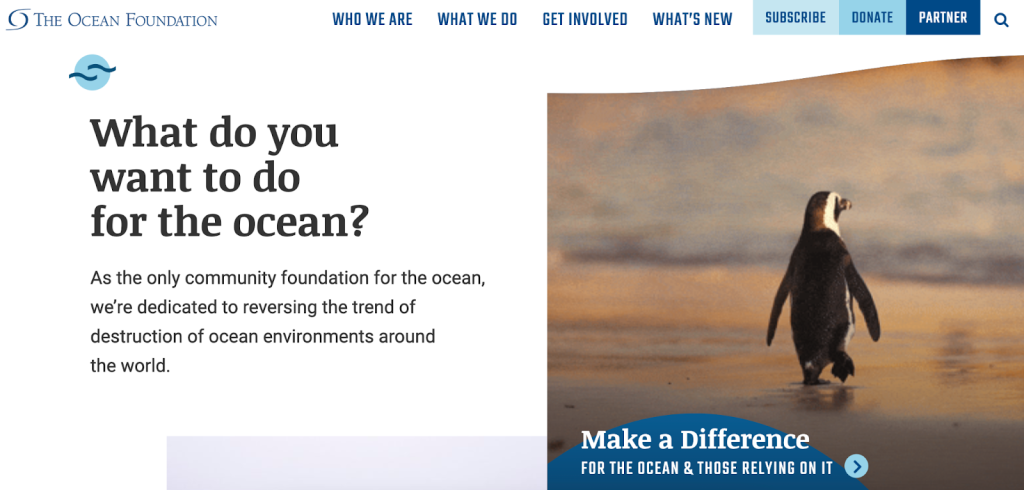
The Ocean Foundation was founded by Wolcott Henry in 2003 as a community foundation committed to reversing ocean degradation globally. Today, they protect our oceans and coastal ecosystems through conservation initiatives, community foundation services, research and development, and blue carbon offsets.
“Our focus is the ocean. And our community is every one of us who depends upon her.”
The Ocean Foundation
Project overview: The Ocean Foundation has a carbon calculator for flights, households, and businesses as well as a direct carbon offset. Purchases support the planting of seagrass. Seagrass meadows are an important carbon sink and store 11% of the ocean’s buried carbon despite only accounting for only 0.1% of the world’s seafloor.
Carbon offset effectiveness: Their seagrass carbon offsets are certified by the Verified Carbon Standard.
Carbon offset costs: It costs $20 per 1,000kg of CO2 offset.
How to get your carbon offsets: You can visit their website to get your blue carbon offsets.
SeaTrees: Regenerating Blue Carbon Coastal Ecosystems
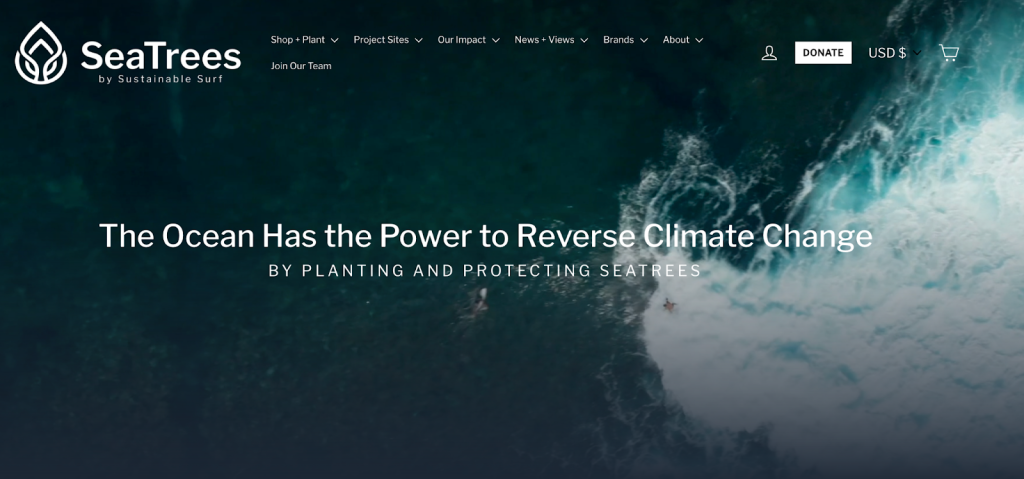
SeaTrees was founded in 2018 as a program of the non-profit organization Sustainable Surf to plant, protect, and restore blue carbon coastal ecosystems. Today, they have 16 active projects worldwide involving mangrove planting, kelp/seagrass/coral reef restoration, and watershed protection.
“We can come together + act now to restore coastal ecosystems.”
SeaTrees
Carbon offset overview: SeaTrees is a nonprofit environmental organization that restores coral reefs, plants mangrove trees, restores kelp forests, and restores watersheds in the US, Indonesia, and Kenya. Their custom blended carbon offset product, the SeaTrees Token, combines carbon credits with innovative blue carbon projects. Each SeaTrees Token purchased sequesters 1 ton of CO2 via Verified Carbon Standard certified offset projects, plants 4 mangrove trees, and creates 1 square foot of kelp forest.
Carbon offset effectiveness: SeaTrees projects are verified according to the Verified Carbon Standard and contribute to multiple UN Sustainable Development Goals. Two of their planting partners also include Eden Reforestation Projects, which are included in our list of the Best Charities for Reforestation, and Wildlife Works, which are included in our list of the Best REDD+ Carbon Offsets.
Carbon offset costs: It costs $22 per 1,000kg of CO2 offset.
How to get your carbon offsets: You can visit their website to purchase your blue carbon offsets.
One Tree Planted: A Global Mangrove Restoration Project
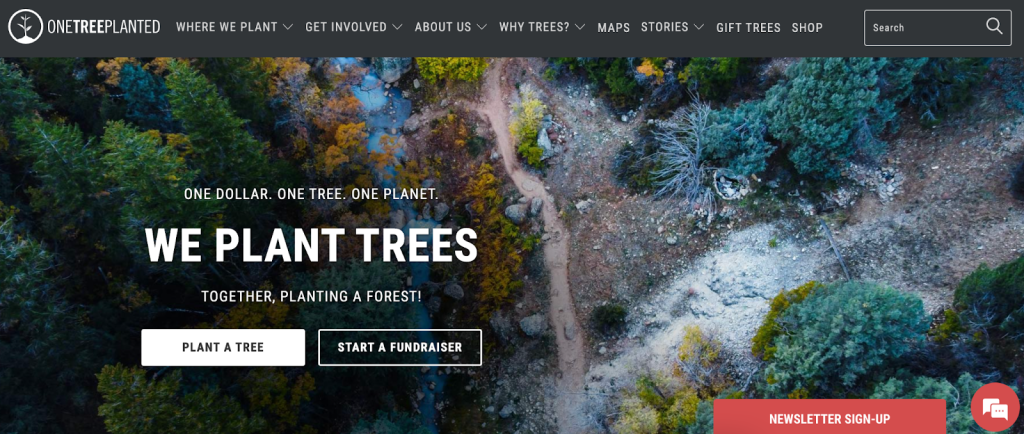
One Tree Planted was founded in 2014 by Matt Hill as a way to make it easier for individuals and businesses to aid in environmental conservation and reforestation across the globe. Today, they have planted over 40 million trees in more than 47 countries.
“One dollar. One tree. One planet.”
One Tree Planted
Carbon offset overview: One Tree Planted is a nonprofit environmental organization that plants trees in North America, Latin America, Africa, Asia, Europe, and the Pacific. Their mangrove planting blue carbon project plants mangrove trees in Asia and Latin America, more specifically in Costa Rica, The Philippines, India, Haiti, and Guatemala. This project helps restore coastline communities and protects millions of people from climate change impacts (e.g., cyclones, erosion, and tidal surges).
Carbon offset effectiveness: One Tree Planted’s offsets are certified by the Climate Action Reserve.
Carbon offset costs: One Tree Planted offers 3 offset options that offset 10, 20, and 30 tonnes of CO2 at a cost of $20 per 1,000kg of CO2. You can also contribute to the mangrove planting project directly at a cost of $1 per tree planted.
How to get your carbon offsets: You can visit their website to view their mangroves project and purchase your carbon offsets.
Reforest’Action: Sumatran Mangrove Restoration
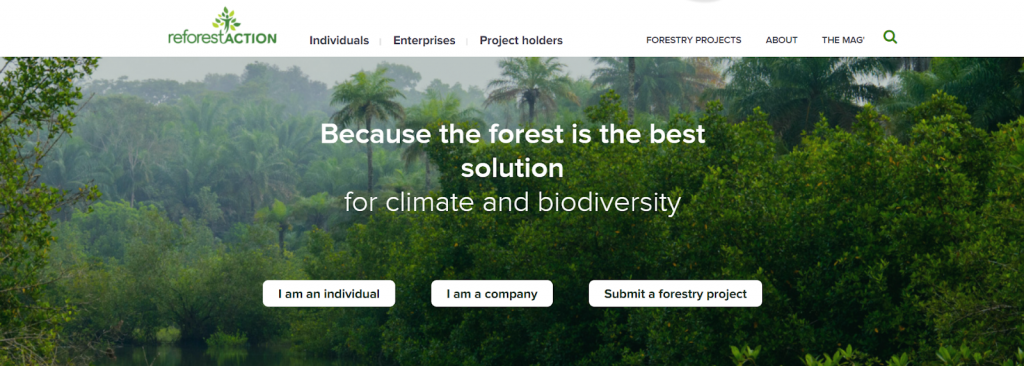
Reforest’Action was founded in 2010 by Stéphane Hallaire as a French crowd-planting company. Today, they have financed more than 20 million trees in 40 different countries in order to preserve, restore, and create forests on a global scale.
“Because the forest is the best solution for climate and biodiversity”
Reforest’Action
Project overview: Reforest’Action currently has active projects in Europe, North America, South America, Africa, Asia, and Oceania. And they support two mangrove restoration projects in Sumatra, an island in Indonesia. Between 2017 and 2024, these projects will have helped reconstitute over 2,200 acres of mangroves.
Carbon offset effectiveness: Reforest’Action’s projects are third-party verified by Ecocert Environnement, a leader in the field of forestry and reforestation.
Carbon offset costs: It costs approximately $19.30 per 1,000kg of CO2 for a direct carbon offset and $20 per 1,000kg of CO2 for an offset subscription. You can also plant or gift trees at a cost of $3.30 per tree.
How to get your carbon offsets: You can purchase your blue carbon offsets by first visiting Reforest’Action’s carbon footprint calculator. Reforest’Action also offers the option to plant trees, gift trees, or subscribe to a monthly plan.
South Pole: Restoring Indonesian Peat Swamp Forests
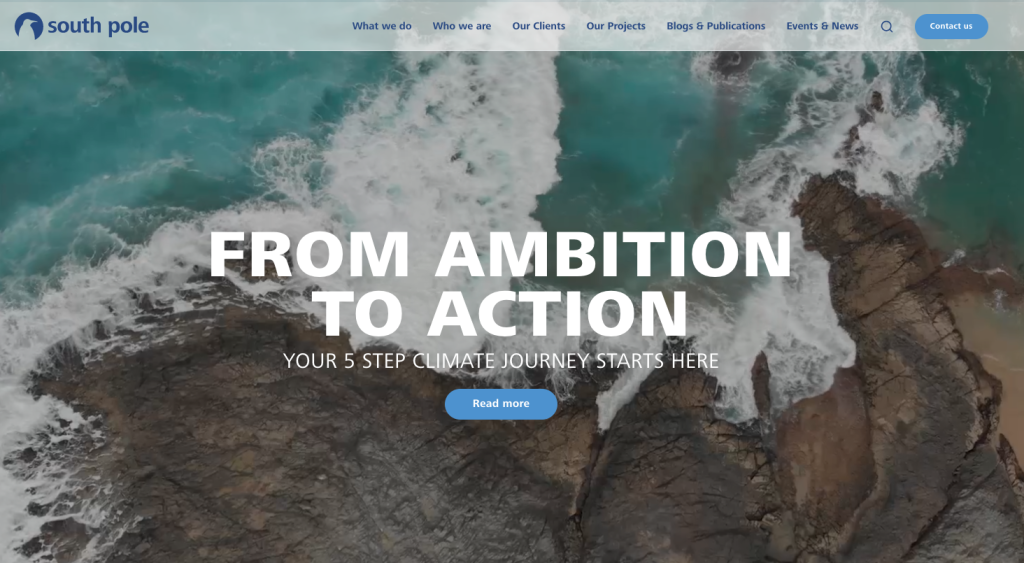
South Pole was founded in 2006 by 5 graduate students from the Swiss Federal Institute of Technology (ETH) as a platform to confront climate change. Today, they offer a wide variety of climate solutions including environmental credits, carbon offsets, and RECs.
“From ambition to action”
South Pole
Project overview: South pole has developed over 700 climate action projects worldwide, and in terms of blue carbon they support the Rimba Raya Biodiversity Preserve project on the island of Borneo in Indonesia and the Muskitia blue carbon project in Honduras. Rimba Raya protects over 200,000 acres of tropical peat swamp, preserves crucial habitats, and avoids the deforestation of over 100,000 acres of forests. Muskitia protects 5,000 ha (120,000 ac) of mangroves and prevents 62,500 tons of CO2 from being released into the atmosphere.
Carbon offset costs: The Rimba Raya Biodiversity project costs $21.55 per 1,000kg of CO2.
How to get your carbon offsets: You can visit South Pole’s website to purchase your blue carbon offsets.
Sustainable Travel International: Restoring Indonesian Peat Swamp Forests
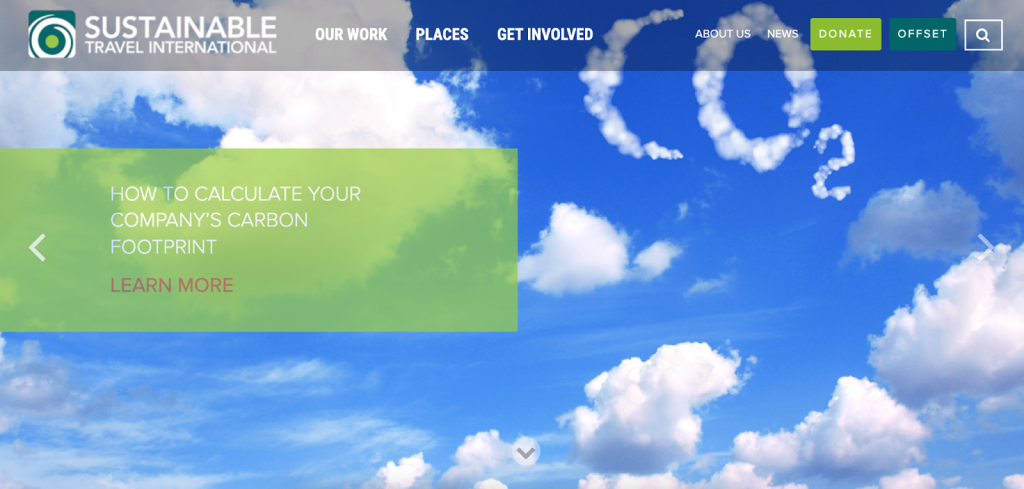
Sustainable Travel International was founded in 2002 by Brian Mullis to transform tourism’s impact on nature and communities by protecting and conserving this planet’s most vulnerable destinations. Today, they have helped individuals and companies offset over 386,309 metric tons (over 386 million kg) of CO2 and have supported various carbon offset projects.
“We’re dedicated to minimizing the negative impacts of tourism and maximizing its positive benefits for people, cultures, nature, and wildlife around the globe”
Sustainable Travel International
Project overview: Sustainable Travel International supports the Katingan Mentaya Blue Carbon Project. This project protects and restores 370,000+ acres of peat swamp forest in Kalimantan, Borneo, one of the largest remaining intact peat swamp forests in Indonesia. The area is also home to 14 endemic species and contains 5% of the world’s remaining Borneo orangutan, proboscis monkey, and Borneo white-bearded gibbons species.
Carbon offset effectiveness: The Katingan Mentaya Blue Carbon Project is certified by the Verified Carbon Standard and the Climate, Community, and Biodiversity Standard.
Carbon offset costs: It costs $16 per 1,000kg of CO2 offset.
How to get your carbon offsets: You can visit their website to purchase your travel, individual, or business carbon offsets.
Restore the Earth Foundation: Reforesting North American Wetlands
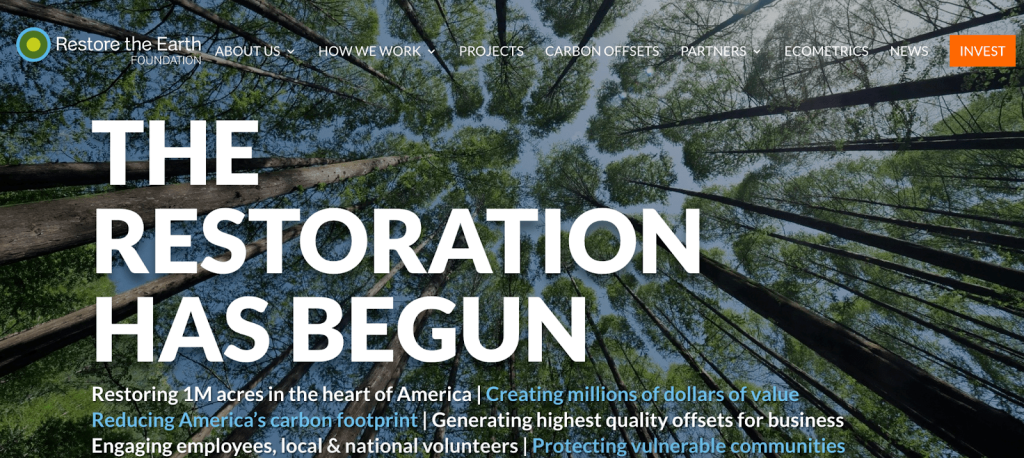
Restore the Earth Foundation was founded in 2008 by Marvin and PJ Marshall after Hurricane Katrina devastated the southern US in 2005. Today, they have reforested over 100,000 acres of forest along the US Gulf Coast and aim to restore 1 million acres total in the Lower Mississippi River Basin.
“The restoration has begun.”
Restore the Earth Foundation
Carbon offset overview: Restore the Earth plants trees in the Lower Mississippi River
Basin, also known as the North American Amazon. This 1 million-acre area is the most ecologically damaged region in North America, where over 80% of forested wetlands have already disappeared. Restore the Earth’s overall goal is to plant 100 million trees in this area, a process that generates blue carbon offsets.
Carbon offset effectiveness: Restore the Earth Foundation’s blue carbon offsets are certified according to either the Climate Action Reserve, American Carbon Registry, or Verified Carbon Standard.
Carbon offset costs: Costs are determined after initial contact.
How to get your carbon offsets: You can visit Restore the Earth’s website to contact a representative and get your carbon offsets.
Ecologi: Coastal Mangrove Planting
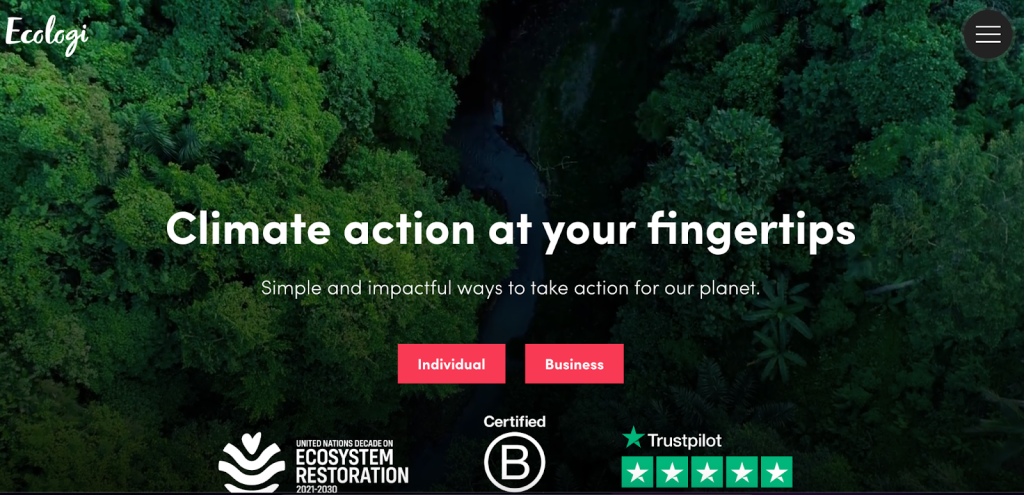
Ecologi was founded in 2019 by Elliot Coad, Lucy Jack, and Alex Price as an answer to the question “what if I put the money from my morning coffee into climate action”? Today they have funded over 57 million trees, avoided over 2 million tons of carbon, and continue to enable everyday people to tackle the current climate crisis via carbon offsetting projects.
“For less than the cost of a cup of coffee per week you can become climate positive.”
Ecologi
Project overview: Examples of blue carbon projects include two mangrove planting projects in Madagascar and one in Mozambique. These projects support coastal mangrove planting, which is a main carbon sink. Since the beginning, many of the trees Ecologi has funded have been mangroves because they have a higher carbon sequestration rate than tropical forests.
Carbon offset effectiveness: Ecologi’s offsetting projects are certified by either the Gold Standard or the Verified Carbon Standard and contribute to multiple UN Sustainable Development Goals. And their projects in Mozambique and Madagascar are carried out by Eden Reforestation Projects, which are included in our list of the Best Charities for Reforestation. They also have an interactive google sheet where you can check when, where, and how many trees are planted through their platform.
Carbon offset costs: It costs approximately $6.04 per 1,000 kg of CO2 offset. And if you scroll further down, you can plant 1 extra tree in the US for only $1.20 per month.
How to get your carbon offsets: You can visit Ecologi’s website to learn more about their mangrove planting projects and get your carbon offsets.
The Carbon Offset Company: Mangrove Reforestation
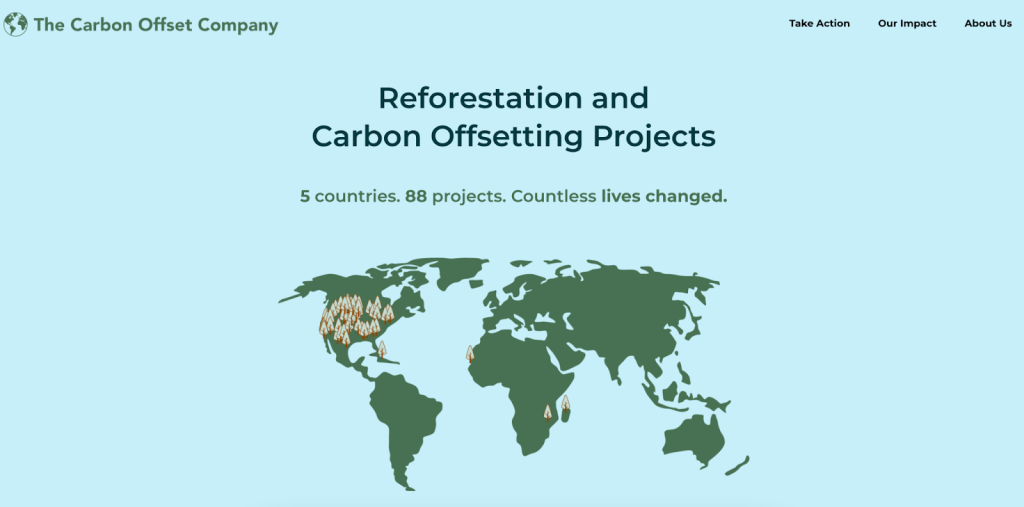
The Carbon Offset Company was founded in 2020 by Matt Kalstrom as a way for individuals and businesses to join the climate battle. Today, they manage reforestation carbon offset projects in 5 countries, have planted over 1.5 million trees, and have offset over 1 million pounds of CO2.
“5 countries. 88 projects. Countless lives changed.”
The Carbon Offset Company
Project overview: The Carbon Offset Company plants trees in the US, Senegal, Madagascar, Haiti, and Mozambique. Their mangrove reforestation blue carbon project is located in Casa Partida, Mozambique. By partnering with Eden Reforestation projects, they use their employ-to-plant method to pay local communities to restore degraded mangrove forests and provide erosion control, habitat protection, and coral reef safeguarding.
Carbon offset effectiveness: The Carbon Offset Company’s offsets are verified by independent, third-party auditors including the Climate Action Reserve, Verified Carbon Standard, Climate, Community and Biodiversity Standard, American Carbon Registry, and the United Nations Clean Development Mechanism. Their reforestation partners include Trees for the Future, Plant With Purpose, National Forest Foundation, One Tree Planted, and Eden Reforestation Projects, all of which are included in our list of the Best Charities for Reforestation.
Carbon offset costs: Costs are determined after initial contact.
How to get your carbon offsets: You can visit their website to get in touch with a representative and get your carbon offsets.
myclimate: Blue Forests for Coral Reef Protection
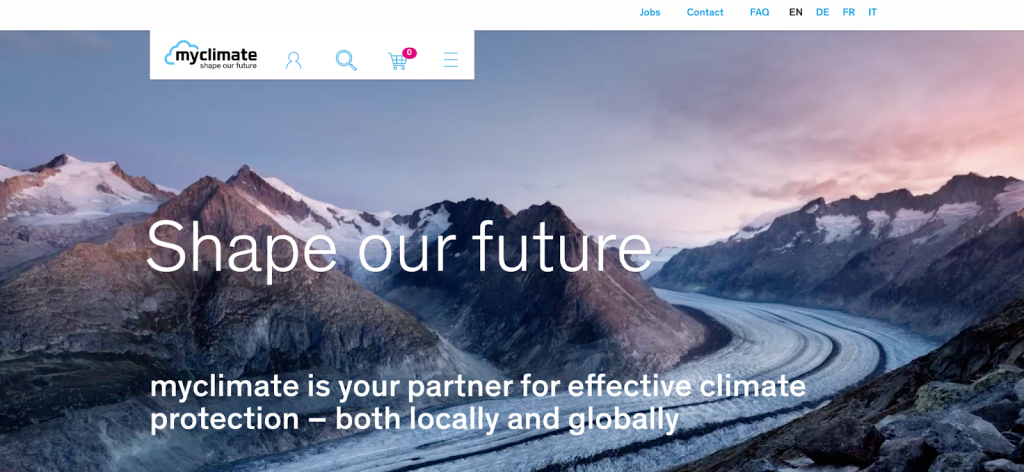
myclimate was founded in 2002 by Renat Heuberger, Thomas Camerata and Patrick Bürgi as an international climate organization with Swiss roots. Today, they have expanded to 45 countries and work with companies of all sizes, public administrations, non-profit organizations, and private individuals to provide high-quality carbon offset projects with quantifiable climate protection.
“myclimate is your partner for effective climate protection – locally and globally”
Myclimate
Carbon offset overview: myclimate provides a variety of carbon offsets for individuals. Specifically, they support the Blue Forests for Coral Reef Protection in Madagascar project, which protects over 2,400 acres of mangrove forests and restores degraded areas.
Carbon offset effectiveness: myclimate projects are certified according to either the Gold Standard, Verified Carbon Standard, or Plan Vivo and contribute to the UN’s Sustainable Development Goals.
Carbon offset costs: It costs approximately $30 per 1,000kg of CO2 offset for an individual carbon offset and $23 per 1,000kg of CO2 offset for a monthly, quarterly, or annual offset subscription.
How to get your carbon offsets: You can visit their website to learn more about the mangrove project and to purchase your carbon offsets.
How Effective and Efficient Are Blue Carbon Offsets
In terms of effectiveness, blue carbon offsets reinforce our marine carbon sink and can continue to avoid CO2 emissions after project durations. However, they also often lack permanence and large-scale funding, and they do not reduce your own carbon emissions.
In terms of efficiency, blue carbon offsets are efficient at carbon sequestration and storage and are relatively cost-effective. However, they also lack a standardized methodology.
Blue carbon offsets are effective at mitigating climate change because they:
- Reinforce our marine carbon sink, which absorbs roughly 25% of the carbon we emit every year
- Can continue to avoid CO2 emissions after their project life span, so long as they are not deforested prematurely
However, blue carbon offsets can also lack effectiveness because they:
- Often lack permanence because they are nature-based, reversible solutions
- Only receive a fraction of total climate investments globally despite being capable of providing 1/3 of the total emissions reductions needed to keep global warming below 2 degrees Celsius
Blue carbon offsets are efficient at reducing CO2 emissions because they:
- Are can sequester carbon at higher rates per unit area than terrestrial ecosystems and store it for long periods of time
- Are a relatively cost-effective method of carbon emission reduction when compared to other methods
However, blue carbon offsets can also lack efficiency because there is no overarching mechanism to regulate the carbon stored in coastal, marine, or wetland soils and biomass. Leading standards all have different methodologies for assessing blue carbon.
Blue carbon offsets also do not reduce your own carbon emissions, which can lead to greenwashing. This occurs when emissions are only offset and not reduced from the source, and the consumer is deceived into thinking they are offsetting their emissions but in reality, they are not. This is why we should first reduce our emissions before relying on offsets.
What Are The 6 Pros and 4 Cons of Blue Carbon Offsets
Blue carbon offsets reinforce our marine carbon sinks, can continue to avoid CO2 emissions after project durations, preserve biodiversity, help maintain water quality, are relatively cost-effective, and allow us to reduce carbon emissions in ways we wouldn’t be able to accomplish individually.
Blue carbon offsets often lack permanence, a standardized methodology, large-scale funding, and they do not reduce your own carbon emissions.
What Are the 6 Pros of Blue Carbon Offsets
Blue carbon offsets have various pros that make them effective at absorbing carbon from our atmosphere.
| 6 Pros of Blue Carbon Offsets | Quick Facts |
| #1: Blue carbon offsets reinforce our marine carbon sink | Blue carbon ecosystems can permanently store carbon at depths of up to 6 meters for up to 1,000 years. They can also sequester carbon at higher rates per unit area than terrestrial ecosystems, making them an important carbon sink. |
| #2: Blue carbon offsets can continue to avoid CO2 emissions after their project life span | Blue carbon projects can continue to reduce carbon emissions long after mangroves have been planted, so long as they are not deforested, because trees can continue absorbing carbon long after they mature. |
| #3: Blue carbon offsets preserve biodiversity | Blue carbon offsets promote biodiversity because they support aquatic wildlife by providing habitat and helping to keep our waterways healthy. A number of birds, fish, invertebrates, mammals, and plants rely on mangroves, seagrass, and salt marshes for habitats. |
| #4: Blue carbon offsets help maintain water quality | All trees capture, store, and use rainfall which aids in maintaining water quality and regulating the natural water cycle. More specifically, blue carbon ecosystems play an important role in regulating water quality because they act as giant water filters. |
| #5: Blue carbon offsets are cost-effective | Blue carbon offsets themselves are typically more cost-effective than other categories of carbon offsets. For example, blue carbon offsets from leading providers (e.g., The Ocean Foundation, One Tree Planted, Reforest’Action, and South Pole) cost less than $30 per ton of CO2 offset. |
| #6: Blue carbon offsets allow us to reduce carbon emissions in ways we wouldn’t be able to accomplish individually | Blue carbon offsets allow us to reduce emissions from activities where sustainable alternatives are not yet widely available. |
What Are the 4 Cons of Blue Carbon Offsets
Understanding the drawbacks of blue carbon offsets is important when implementing this strategy on a large scale in order to mitigate climate change.
| 4 Cons of Blue Carbon Offsets | Quick Facts |
| #1: Blue carbon offsets often lack permanence | Nature-based solutions, such as blue carbon, lack permanence. Blue carbon ecosystems are currently being degraded at 4 times the rate of tropical forests. Climate change is one of the leading factors that can negate blue carbon permanence. |
| #2: Blue carbon offsets lack a standardized methodology | The storage of carbon in terrestrial ecosystems is well documented and managed via the Reducing Emissions from Deforestation and Forest Degradation (REDD+) mechanism. However, there is no overarching mechanism to regulate the carbon stored in coastal, marine, or wetland soils and biomass. |
| #3: Blue carbon offsets lack large-scale funding | Although they are capable of providing 1/3 of the total emissions reductions needed to keep global warming below 2 degrees Celsius, blue carbon ecosystems only receive 3% of total climate investments globally. |
| #4: Blue carbon offsets do not reduce your own carbon emissions, which can lead to greenwashing | If emissions are only offset and not reduced from the source, this could lead to greenwashing, when the consumer is deceived into thinking they are offsetting their emissions but in reality, they are not. |
How Can Blue Carbon Offsets Help Mitigate Climate Change
Climate change is a severe and long-term consequence of fossil fuel combustion. Blue carbon offsets can help mitigate climate change because they protect our coastal marine ecosystems. The healthier they are, the more CO2 they can absorb from our atmosphere. Atmospheric carbon can, if left untreated, remain there for tens of thousands of years and exacerbate the negative effects of climate change.
How is Climate Change Defined
Climate change is arguably the most severe, long-term global impact of fossil fuel combustion. Every year, approximately 33 billion tons (bt) of CO2 are emitted from burning fossil fuels. The carbon found in fossil fuels reacts with oxygen in the air to produce CO2.
“Climate change: changes in the earth’s weather, including changes in temperature, wind patterns and rainfall, especially the increase in the temperature of the earth’s atmosphere that is caused by the increase of particular gasses, especially carbon dioxide.”
Oxford Dictionary
Atmospheric CO2 fuels climate change, which results in global warming. When CO2 and other air pollutants absorb sunlight and solar radiation in the atmosphere, it traps the heat and acts as an insulator for the planet. Since the Industrial Revolution, Earth’s temperature has risen a little more than 1 degree Celsius (C), or 2 degrees Fahrenheit (F). Between 1880-1980 the global temperature rose by 0.07C every 10 years. This rate has more than doubled since 1981, with a current global annual temperature rise of 0.18C, or 0.32F, for every 10 years.
As outlined in the 2015 Paris Climate Agreement, we must cut current GHG emissions by 50% by 2030 and reach net zero by 2050.
How Do Carbon Offsets Generally Help Mitigate Climate Change
Levels of carbon in our atmosphere that cause climate change have increased as a result of human emissions since the beginning of the Industrial Revolution in 1750. The global average concentration of CO2 in the atmosphere today registers at over 400 parts per million. Carbon offsets can help prevent these levels from increasing even more.
When you hear the words “carbon offset”, think about the term “compensation”. Essentially, carbon offsets are reductions in GHG emissions that are used to compensate for emissions occurring elsewhere.
Carbon offsets that meet key criteria and verified project standards, are additional and permanent, and are part of projects that are carried out until the end of their lifespan have the best chance of reducing carbon emissions and therefore reducing climate change.
When we offset CO2 we also slow the rate of global temperature rise, which in turn minimizes the effects of climate change.
How Do Blue Carbon Offsets Specifically Help Mitigate Climate Change
Blue carbon offsets specifically help mitigate climate change because they protect coastal and marine ecosystems, which are capable of absorbing more CO2 per acre than rainforests and at a rate 10x greater. The more we reinforce these ecosystems, the more we enable them to absorb CO2 from the atmosphere and store it in biomass and soils for long periods of time.
Final Thoughts
The Ocean Foundation, SeaTrees, and One Tree Planted, and Reforest’Action are the best blue carbon offsets. South Pole and Sustainable Travel International support blue carbon projects in Indonesia, Restore the Earth Foundation in the United States, Ecologi and The Carbon Offset Company in Mozambique, and myclimate in Madagascar.
Blue carbon offsets protect, preserve, and plant trees in coastal and marine ecosystems, which can absorb large amounts of CO2. But for all of the good carbon offsets can instigate, they should not be seen as the only solution to climate change. They are effective at reducing CO2 in the short term, but in the long term, they fail to reduce CO2 enough.
When used in conjunction with direct CO2 reduction measures, carbon offsetting can be much more effective. We should reduce our own carbon footprint as much as possible first, and only then choose the most effective blue carbon offsets.
Stay impactful,

Sources
- McKinsey Sustainability: Blue carbon – The potential of coastal and oceanic climate action
- U.S. Environmental Protection Agency: Offsets and RECs -What’s the Difference?
- Britannica: Carbon Offset
- David Suzuki Foundation: Are carbon offsets the answer to climate-altering flights?
- The United Nations Educational, Scientific and Cultural Organization: Blue Carbon
- University of California, Davis: What is Carbon Sequestration and How Does it Work? | CLEAR Center
- Client Earth: What is a Carbon Sink?
- National Oceanic and Atmospheric Administration: What is Blue Carbon?
- United States Evironmental Protection Agency: Ecosystem Services Research
- Impactful Ninja: What Are Blue Carbon Offsets and How Do They Work? The Big Picture
- The Ocean Foundation: Homepage
- The Ocean Foundation: About the Ocean Foundation
- The Ocean Foundation: Calculator
- The Ocean Foundation: Why Go Blue?
- The Ocean Foundation: Donate to Seagrasss Grow
- Charity Navigator: The Ocean Foundation
- GuideStar: Ocean Foundation
- SeaTrees: Homepage
- SeaTrees: About Us
- SeaTrees: Projects
- SeaTrees: SeaTrees FAQ
- United Nations Department of Economic and Social Affairs: The 17 Goals
- Eden Reforestation Projects: Homepage
- Impactful Ninja: 9 Best Charities for Reforestation
- Wildlife Works: Homepage
- Impactful Ninja: Best REDD+ Carbon Offsets
- SeaTrees: Wipe Out CO2 by the Ton
- One Tree Planted: Homepage
- One Tree Planted: About us
- One Tree Planted: Where We Plant
- One Tree Planted: Plant Trees for Mangrove Restoration
- Climate Action Reserve: Homepage
- One Tree Planted: Carbon Offset
- Reforest’Action: Homepage
- Reforest’Action: Our Mission
- Reforest’Action: A Unique Model of Crowdplanting
- Reforest’Action: Our Reforestation Projects
- Reforest’Action: Reforestation in Asia
- Reforest’Action: The regenerated mangrove of Sumatra
- Ecocert: Homepage
- Reforest’Action: Subscribe to the Forest!
- Reforest’Action: Offer a Tree
- Reforest’Action: I Plant Trees
- South Pole: Homepage
- South Pole: Climate Action Projects
- South Pole: Our Mission
- South Pole: Explore Projects
- South Pole: Muskitia Blue Carbon
- Sustainable Travel International: Homepage
- Sustainable Travel International: About Us
- Sustainable Travel International: Carbon Offsets
- Sustainable Travel International: Blue Carbon Offset Projects
- Sustainable Travel International: offset by amount
- Restore the Earth Foundation: Homepage
- Restore the Earth Foundation: Mission & Vision
- Restore the Earth Foundation: Carbon Offsets
- Restore the Earth Foundation: Projects
- Climate Action Reserve: Homepage
- Restore the Earth Foundation: Contact Us
- Ecologi: Homepage
- Ecologi: Reforestation and Carbon Offsetting Projects
- Ecologi: Mangrove planting at Belavenika, Madagascar
- Ecologi: Mangrove planting in Irregele Milato, Mozambique
- Gold Standard: Homepage
- Verified Carbon Standard: Homepage
- Impactful Ninja: 9 Best Charities for Reforestation
- Ecologi: Ecologi Public Impact & Operations Ledger
- Ecologi: Your Plan
- The Carbon Offset Company: Homepage
- The Carbon Offset Company: A More Sustainable Future
- The Carbon Offset Company: Casa Patrtida, Mozambique
- Climate Action Reserve: Homepage
- Climate, Community and Biodiversity Standard: Homepage
- American Carbon Registry: Homepage
- United Nations Framework Convention on Climate Change: The Clean Development Mechanism
- Trees for the Future: Homepage
- Plant With Purpose: Homepage
- The National Forest Foundation: Homepage
- Impactful Ninja: 9 Best Charities for Reforestation
- The Carbon Offset Company: Verified Carbon Credits to Offset Your Emissions
- myclimate: Homepage
- myclimate: About myclimate
- myclimate: Blue Forests for Coral Reef Protection in Madagascar
- Plan Vivo: Homepage
- United Nations Department of Economic and Social Affairs: The 17 Goals
- Myclimate: Calculate your flight emissions
- myclimate: Carbon Offset Subscriptions
- Phys.org: Do oceans absorb more CO2 than expected?
- Carbon Offset Guide: Permanence
- The Institute for Carbon Removal Law and Policy: Nature-Based Solutions
- Verra: Verra Seeks Applicants to Join Two New Biosequestration Working Groups
- GreenBiz: What will it cost to save the earth’s oceans?
- GreenBiz: Blue carbon will be the next frontier of carbon crediting
- Edie: Carbon offsetting – How are businesses avoiding greenwashing on the road to net-zero?
- Impactful Ninja: How Effective and Efficient Are Blue Carbon Offsets? Here Are the Facts
- Nature: Why are Mangroves Important?
- Huron River Watershed Council: Trees and Forests Fight Climate Change and Water Pollution
- United States Environmental Protection Agency: Climate Impacts on Coastal Areas
- United Nations Convention Framework on Climate Change: REDD+
- World Nuclear Association: Carbon Emissions from Electricity
- Natural Resources Defense Council: Global Warming 101
- myclimate: What does “net zero emissions” mean?
- National Oceanic and Atmospheric Administration: Climate Change – Atmospheric Carbon Dioxide
- Natural Resources Defense Council: Carbon Offsets 101
- Terrapass: Carbon Offset Projects
- CarbonBetter: What is Blue Carbon?
- The Ocean Foundation: Reduce Your Carbon Footprint
- Energy Information Administration: Renewable Energy Explained
- Energy Star: Compact Fluorescent Light Bulbs (CFLs) and Mercury
- Our World in Data: Where in the world do people have the highest CO2 emissions from flying?
- Zero Waste Europe: Reusable vs Single Use Packaging
- Carbonbrief: Interactive – What is the climate impact of eating meat and dairy?
- Stop Waste: Recycling and Climate Protection
- Impactful Ninja: Is Taking Long Showers Bad for the Environment?
- United States Environmental Protection Agency: Showerheads
- Impactful Ninja: 4 Main Reasons Why Reducing Your Carbon Footprint is Important




